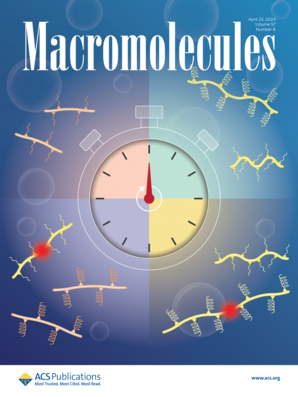Facile Synthesis of High-Molecular-Weight Biobased Polythioethers with Outstanding Mechanical Properties and Intrinsic Antiultraviolet Performance
IF 5.1
1区 化学
Q1 POLYMER SCIENCE
引用次数: 0
Abstract
Common methods, including adding inorganic and organic ultraviolet (UV) absorbers, for preparing anti-UV polymers inevitably have the disadvantages of poor stability, low transparency, and coloration of samples. To overcome these shortcomings, high-molecular-weight polythioethers with excellent intrinsic anti-UV performance were prepared by anion ring-opening polymerization of episulfides derived from the biobased epoxides containing a substituted phenyl group. The mechanical properties, reprocessability, and anti-UV performance of polythioethers were significantly improved through copolymerization and cross-linking modification. A cross-linked copolythioether displayed a UV protection factor value of 91.8 and a light transmittance of over 68% in the visible range and moreover exhibited outstanding mechanical properties with a tensile strength of 17.9 MPa and an elongation at break of 534%. The mechanical properties and anti-UV performance of copolythioether decreased significantly after prolonged exposure to UV light, while the cross-linked copolythioether maintained good stability. This work provided a feasible method for preparing colorless, transparent, and high-performance intrinsic anti-UV polythioethers, which can be used in the manufacture of lenses and can effectively prevent UV-light damage to the eyes.

具有优异力学性能和固有抗紫外线性能的高分子量生物基聚硫醚的简易合成
制备抗紫外线聚合物的常见方法包括添加无机和有机紫外线(UV)吸收剂,但这些方法不可避免地存在稳定性差、透明度低和样品着色等缺点。为了克服这些缺点,研究人员采用阴离子开环聚合法制备了具有优异内在抗紫外线性能的高分子量聚硫醚,这种聚硫醚来自含有取代苯基的生物基环氧化物。通过共聚和交联改性,聚硫醚的机械性能、再加工性和抗紫外线性能得到了显著改善。交联共聚硫醚的紫外线防护系数达到 91.8,在可见光范围内的透光率超过 68%,而且具有出色的机械性能,拉伸强度达到 17.9 兆帕,断裂伸长率为 534%。长时间暴露在紫外线下,共聚硫醚的机械性能和抗紫外线性能明显下降,而交联共聚硫醚则保持了良好的稳定性。这项工作为制备无色、透明、高性能的本征抗紫外线聚硫醚提供了一种可行的方法,这种聚硫醚可用于制造镜片,并能有效防止紫外线对眼睛的伤害。
本文章由计算机程序翻译,如有差异,请以英文原文为准。
求助全文
约1分钟内获得全文
求助全文
来源期刊

Macromolecules
工程技术-高分子科学
CiteScore
9.30
自引率
16.40%
发文量
942
审稿时长
2 months
期刊介绍:
Macromolecules publishes original, fundamental, and impactful research on all aspects of polymer science. Topics of interest include synthesis (e.g., controlled polymerizations, polymerization catalysis, post polymerization modification, new monomer structures and polymer architectures, and polymerization mechanisms/kinetics analysis); phase behavior, thermodynamics, dynamic, and ordering/disordering phenomena (e.g., self-assembly, gelation, crystallization, solution/melt/solid-state characteristics); structure and properties (e.g., mechanical and rheological properties, surface/interfacial characteristics, electronic and transport properties); new state of the art characterization (e.g., spectroscopy, scattering, microscopy, rheology), simulation (e.g., Monte Carlo, molecular dynamics, multi-scale/coarse-grained modeling), and theoretical methods. Renewable/sustainable polymers, polymer networks, responsive polymers, electro-, magneto- and opto-active macromolecules, inorganic polymers, charge-transporting polymers (ion-containing, semiconducting, and conducting), nanostructured polymers, and polymer composites are also of interest. Typical papers published in Macromolecules showcase important and innovative concepts, experimental methods/observations, and theoretical/computational approaches that demonstrate a fundamental advance in the understanding of polymers.
 求助内容:
求助内容: 应助结果提醒方式:
应助结果提醒方式:


